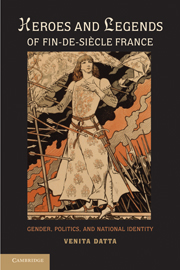Book contents
- Frontmatter
- Contents
- Acknowledgments
- Introduction: The Fin-de-Siècle Cult of Heroes
- 1 Gender, Class, and Heroism in the Bazar de la Charité Fire of 1897
- 2 Cyrano: A Hero for the Fin de Siècle?
- 3 “L'Appel au Soldat”: Visions of the Napoleonic Legend in Popular Culture
- 4 On the Boulevards: Representations of Joan of Arc in the Popular Theater
- 5 Opium, Gambling, and the Demimondaine: The Ullmo Spy Case of 1907–1908
- Conclusion: From One War to the Next: The End of Heroes?
- Selected Bibliography
- Index
4 - On the Boulevards: Representations of Joan of Arc in the Popular Theater
Published online by Cambridge University Press: 05 June 2012
- Frontmatter
- Contents
- Acknowledgments
- Introduction: The Fin-de-Siècle Cult of Heroes
- 1 Gender, Class, and Heroism in the Bazar de la Charité Fire of 1897
- 2 Cyrano: A Hero for the Fin de Siècle?
- 3 “L'Appel au Soldat”: Visions of the Napoleonic Legend in Popular Culture
- 4 On the Boulevards: Representations of Joan of Arc in the Popular Theater
- 5 Opium, Gambling, and the Demimondaine: The Ullmo Spy Case of 1907–1908
- Conclusion: From One War to the Next: The End of Heroes?
- Selected Bibliography
- Index
Summary
Like Cyrano and Napoleon, Joan of Arc, the lone female hero in this trio of military heroes, became a touchstone for both gender and national identities during the fin de siècle. Indeed, the nineteenth century witnessed a revival of the Joan of Arc cult with the fin de siècle marking the apotheosis of the Joan of Arc legend. Whereas the Napoleonic legacy had not always succeeded in finding a unity “beyond politics,” representations of Joan of Arc in the boulevard theater, especially as she was depicted by Sarah Bernhardt, managed to unite fin-de-siècle audiences, especially during the belle époque years immediately preceding the First World War.
The memory of Joan, however, was not neutral; rather, it was divisive, reflecting long-standing divisions in French society. Rosemonde Sanson and Gerd Krumeich have both argued that the struggle between right and left to co-opt Joan during the fin de siècle ultimately led to the right finally succeeding in the years preceding World War I in making Joan a symbol of political conservatism. Michel Winock and Robert Gildea, on the other hand, recognize that this co-option was neither complete nor entirely successful, pointing to the emergence of Joan as a figure of national unity during the war and immediately after.
- Type
- Chapter
- Information
- Heroes and Legends of Fin-de-Siècle FranceGender, Politics, and National Identity, pp. 142 - 178Publisher: Cambridge University PressPrint publication year: 2011



